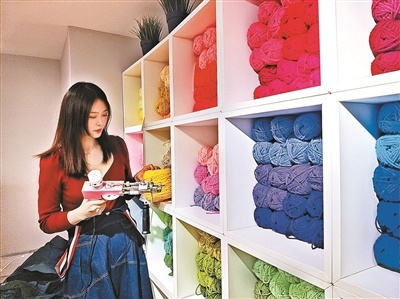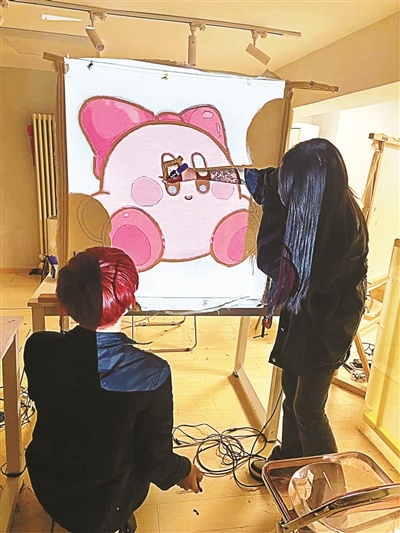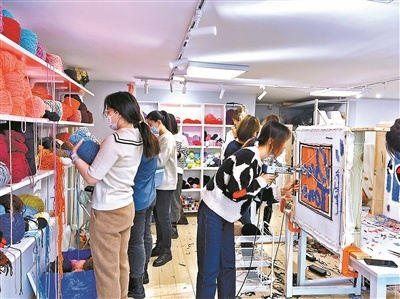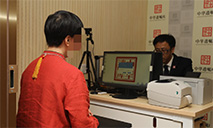Tufting becomes trendy among China’s young people as a new hands-on DIY experience
“Tufting,” or the making of creations with yarn of various colors and a tufting gun, has become a new obsession among young Chinese, who find that this handicraft helps to relieve some of their pressure.

A young woman selects wool for her tufting handiwork craft. (Photo provided by the interviewee)
The craft starts with designing a pattern. One can draw it on a piece of cloth, or make use of projections for relatively more complicated ones. After completing this step one can then select the wool they wish to use. Beginners will also need to learn how to use the tufting gun and practice for a while on another piece of cloth before they begin the most important part of the craft-making process. To do the tufting, one will need to first press the gun hard onto the cloth, turn on the gun’s switch, push the trigger over and over, and lift the gun in a rhythmic fashion, filling in all the color blocks with countless numbers of lines. After that process is complete, the wool on the frontside of the cloth will form into a bunch. But there are still some additional steps, like trimming the excess wool and gluing the work onto a mat, before the artwork can finally be finished. By using these tufting craft-making techniques, it is possible to create a wide range of works, such as blankets, mirror frames, smart phone cases, mats, cushions and bags.
“I focused single-mindedly on my work without getting distracted when I was punching through the cloth with the gun. All I was thinking was keeping my lines straight,” said Mao, who first experienced tufting at a workshop. Mao said she was not so good at handiwork, but found that tufting was actually not all that difficult. “What makes it appealing is that it helps me forget other problems for a while. It turns out to be a good way to alleviate pressure,” she said.

A young woman draws a pattern on a piece of cloth before creating her tufting artwork. (Photo provided by the interviewee)
“It was so much fun,” said Xu, a sophomore who just tried tufting with a bestie in a studio. “It took us about six hours to finish a mirror frame each, which was longer than we had expected.” “We even sacrificed our time for watching a TV drama. It’s physically demanding, but really interesting,” Xu added.
Xu had heard about this DIY program before she tried it, and always wanted to give it a go. “Almost everyone around me has all heard of it, but not many have experienced it because it was expensive,” she said. “I tried it at a discounted price of about 200 yuan (about $31.42).”
This is literally the lowest price available at all the tufting workshops. The cost for making a mid-sized work ranges from 298 yuan to 698 yuan, and the cost for a bigger one, with a length of 140 centimeters and a width of 90 centimeters, may be as high as nearly 1,000 yuan.
Despite the high price, Xu hoped to try it again. “I will definitely try it again if there is a discounted price,” she said. “Creating lines with a gun that makes ‘tutu’ sounds is so joyful and stress relieving,” Xu introduced. Having failed many times at making other handiworks, she finally was able to make a lovely mirror frame with the pattern of puppies, which was praised by the shop assistants and her mother. “This really gives me a sense of accomplishment,” she said.

Photo shows three finished tufting handiworks. (Photo provided by the interviewee)
A salaried employee surnamed Yu found it expensive, too. A mat may just cost less than 100 yuan online, but she spent 309 yuan to finish one of the same size herself at a tufting workshop. “I didn’t come to the tufting workshop in order to purchase a mat, but to purchase an experience. It was fine, but I guess I will not try it for a second time,” she said.
This new pastime started to pop up in China starting in September 2021, and is now trendy in the country. There are over 70,000 tufting-related posts on Xiaohongshu, an Instagram-like Chinese fashion and lifestyle-sharing platform, with posts on creating brightly colored tufting handiworks in beautifully decorated workshops or introducing different tufting shops. Official statistics for the platform show that the number of posts on this topic during the fourth quarter of 2021 increased by approximately five times compared to the figure in the third quarter.
The popularity of tufting is based on many different reasons. Like many other DIY programs, tufting helps people to relieve their pressure through working with their hands, according to Zeng Xin, an assistant researcher at the Institute of Journalism and Communication Studies of the Chinese Academy of Social Sciences. Zeng said that the feeling of this hands-on work during the craft-making process is pretty much akin to the feeling of biting on one’s fingers as one did as a toddler, which can help people to relax both mentally and physically. One can concentrate on the work in front of them for several hours without being disturbed.

Photo shows a tufting workshop. (Photo provided by the interviewee)
Besides, with vibrant colors and cute designs, tufting handworks are always visually appealing. Moreover, it is not difficult to learn the craft, even for beginners. It is a good recreational choice for both couples and groups of friends. People can also share the works they make on social media platforms. For these reasons, Zeng remains optimistic about the prospects for DIY tufting programs.
Chinese cities, big or small, have witnessed the emergence of many tufting shops. Search results for “tufting” on Dianping, one of China’s major online service platforms, in each of the major cities of the country have exceeded 100 since the beginning of this year, while there were only about 20 shops all over China as of Nov. 23, 2021. At present, however, the platform indicates that there are 466 shops in Beijing, with most of them located in shopping districts such as Sanlitun and Chaoyang Joy City, and 553 in Guangzhou, south China’s Guangdong Province.
Song, who operates a silver ornaments and glass handicrafts business, spotted the potential and opened a tufting shop in Beijing in December 2021. He said that the textile manufacturing art is easier to promote and create than other handicrafts he once worked on, and explained that the reason for the high price is that it is simply very time consuming. “The wool is cheap, but you must make allowances for the rent of the shop and labor costs,” he introduced, adding that his shop receives a lot more customers during the holidays and weekends than on weekdays.
Photos
 Increasingly more young adults in China register wills that include virtual assets
Increasingly more young adults in China register wills that include virtual assets Rapeseed flowers turn NW China's Luoping into picturesque spring wonderland
Rapeseed flowers turn NW China's Luoping into picturesque spring wonderland Why do people in China fall for animated characters like LinaBell and Bing Dwen Dwen?
Why do people in China fall for animated characters like LinaBell and Bing Dwen Dwen? Photo Album: architecture in Beijing merging history and modernity
Photo Album: architecture in Beijing merging history and modernity
Related Stories
- DIY traditional Chinese lipstick
- Belle opens DIY workshop to enjoy life in the slow lane
- Children DIY cartoon contest launched in Tianjin
- Paralyzed patient given free medical care
- Creative DIY by Chinese students
- DIY activity named "I am a Little Patissiere" held in Yantai, China's Shandong
- DIY Love
- College students cook for themselves in DIY kitchen
- Watch the Calories and DIY Iced Treats
Copyright © 2022 People's Daily Online. All Rights Reserved.






